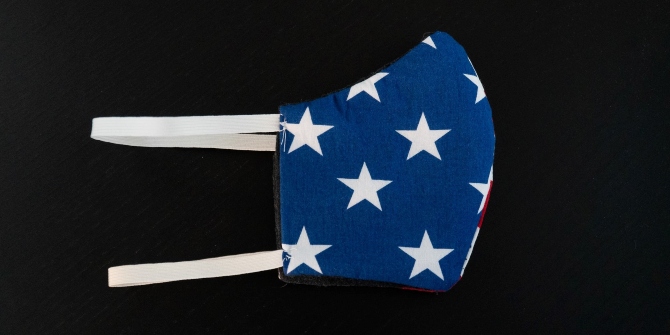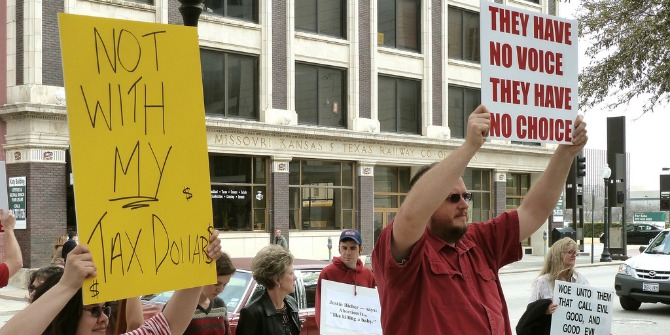
 From the beginnings of the COVID-19 pandemic in early 2020, the administration of President Trump left much of the task of responding to COVID-19 to the states, largely eschewing cooperative measures between the federal and state and local governments. John Kincaid and J. Wesley Leckrone write that while some commentators have lamented that there was not a more centralized response, cooperation between the federal and state and local governments was restricted by partisan polarization and a president ideologically opposed to many COVID-19 mitigation measures.
From the beginnings of the COVID-19 pandemic in early 2020, the administration of President Trump left much of the task of responding to COVID-19 to the states, largely eschewing cooperative measures between the federal and state and local governments. John Kincaid and J. Wesley Leckrone write that while some commentators have lamented that there was not a more centralized response, cooperation between the federal and state and local governments was restricted by partisan polarization and a president ideologically opposed to many COVID-19 mitigation measures.
The most important feature of US responses to COVID-19 has been polarization between the two major political parties: the left-leaning Democrats and right-leaning Republicans. On average, to tackle the pandemic, Democrats have prioritized supporting stay-at-home orders (SAHOs) implemented by state governors and local officials and endorsing federal, state, and local government mask-wearing and vaccination mandates. On average, Republicans have prioritized the economy and individual freedom and opposed SAHOs and mandates. Most Democrats in Congress have supported federal aid to state and local governments and higher and longer unemployment benefits. In contrast, most Republicans have opposed state-local aid and advocated lower and shorter unemployment benefits.
Polarization is an important reason why the United States has the world’s eighteenth highest COVID-19 death rate (227.2 per 100,000 population). The mean death rate in the then 15 Democratic trifecta states (where the party controls the governorship and both legislative chambers) was 192.4 with a mean 63.6 per cent full vaccination rate on 1 November 2021. The mean death rate in the then 23 Republican trifectas was 232.2 with a mean 50.7 percent vaccination rate. The 12 states with divided party control had a mean death rate of 194 with a mean vaccination rate of nearly 58 percent.
Federal government responses
The first confirmed COVID-19 case in the US was on 20 January 2020. On 31 January, President Donald Trump declared a public health emergency and restricted travel from China. Many Democrats labeled him xenophobic. The first US death was announced on 29 February. On 6 March, Trump signed an $8.3 billion emergency appropriation enacted by congressional majorities of both parties. Cases then began to surge in late March and early April.
Despite polarization, large bipartisan majorities in Congress enacted four pandemic relief bills from 18 March to 5 June totaling $2.7 trillion. After the 3 November 2020 presidential election, a fifth bipartisan measure passed on 21 December after months of debate over whether the bill should include aid to state and local governments and other matters. In March 2021, by a mostly party-line vote, congressional Democrats passed a $1.9 trillion relief measure providing $350 billion for state and local governments even though their revenues were more robust than anticipated and many experienced no declines.
On 13 March 2020, Trump issued 57 disaster declarations across all states, Washington, DC, and US territories—the first such declaration in US history. In domestic emergencies, the president is expected to coordinate with state and local officials, who are the first and primary responders. The federal role is normally more supportive and advisory than directive. Although Trump conferred regularly with governors, he acted slowly to provide medical equipment to the states, admonishing governors in March that the federal government was “not a shipping clerk.” Consequently, states competed for equipment over several months in both domestic and global markets. By April, Trump was embroiled in rhetorical combat with many governors, mostly Democrats, calling those who resisted his calls to end stay-at-home orders “mutineers” and tweeting taunts such as “LIBERATE MICHIGAN.”
Trump never forged a cooperative partnership with state and local officials to tackle the pandemic, although many federal agencies such as the Centers for Disease Control and Prevention did so. Instead, Trump adhered to a dual federalist model in which state and local governments remained the primary pandemic responders. The federal courts largely deferred to federal, state, and local government actions.
Trump’s most consequential act was his 15 May 2020 announcement of Operation Warp Speed, a public-private partnership funded with $10 billion to develop a COVID-19 vaccine. Three companies produced vaccines within months, and the first vaccination occurred on 13 December 2020. Mass vaccinations began under Trump and continued under President Joseph Biden.
State and local government responses
State and local governments began responding substantially to the pandemic by 11 March 2020. San Francisco was the first to declare an emergency on 15 February. It banned large gatherings on 11 March and, together with surrounding local governments, implemented a SAHO on 17 March. California issued the first statewide SAHO on 19 March.

Photo by Martin Sanchez on Unsplash
By 7 April, 43 governors had issued SAHOs of varying stringency and scope. Of the first ten SAHO-issuing governors, nine were Democrats. All states having no SAHO had Republican governors. Republican governors who issued SAHOs were the first to ease them. Democratic states experienced higher unemployment and government job losses, producing pressure on congressional Democrats to enact state-local relief. Most Republicans opposed such relief, arguing that Democratic states induced their own woes. Trump tweeted: “Well run [Republican] States should not be bailing out poorly run [Democratic] States, using CoronaVirus as the excuse!”
Most state courts did not interfere with gubernatorial policymaking, although the Republican supreme courts of Michigan and Wisconsin overturned gubernatorial SAHOs. Some Republican state legislatures acted to curtail governors’ emergency powers. Facing a Democratic governor, Pennsylvania’s Republican legislature passed and obtained voter ratification of two state constitutional amendments in November 2020 curbing the governor’s emergency powers.
Conflict occurred between some states and local governments, especially Republican-controlled states such as Texas that have big cities dominated by Democrats. Republican governors and legislatures sought to rein in Democratic cities’ SAHOs and mask and vaccination mandates. In New York, however, the then Democratic governor, Andrew Cuomo’s clashes with New York City’s Democratic mayor, Bill de Blasio delayed the city’s SAHO until 22 March. Also, the governor ordered elderly COVID-19 hospital patients removed to nursing homes. By 22 April, New York, with 5.9 per cent of the US population, had 41.5 percent of US COVID-19 deaths.
Under Trump, a centralized federal response to COVID-19 might have been doomed
Many commentators contend that a centralized COVID-19 response would have been more effective; however, none explain how centralization could have succeeded under Trump. If the states lacked authority to act, President Trump would have terminated a national stay-at-home-order in April 2020, refused to revive SAHOs during subsequent COVID-19 waves, and declined to issue mask or vaccination mandates. Trump was unwilling and unable to forge a more effective cooperative federalism response because both his personality and polarization stymied intergovernmental cooperation.
Further, given the intensified polarization generated by Trump, even under Biden’s more cooperative, centralized and semi-national mask and vaccination mandates, many Americans strongly reject mask-wearing, and only 60 per cent of the US population was fully vaccinated by 24 November 2021. Elite polarization and voter polarization, along with very low levels of trust in the federal government, continue to frustrate more effective intergovernmental COVID-19 policymaking.
- This article is based on the paper, ‘Partisan Fractures in U.S. Federalism’s COVID-19 Policy Responses’ in State and Local Government Review.
Please read our comments policy before commenting
Note: This article gives the views of the authors, and not the position of USAPP– American Politics and Policy, nor of the London School of Economics.
Shortened URL for this post: https://bit.ly/3DerGYL
About the authors
 John Kincaid – Lafayette College
John Kincaid – Lafayette College
John Kincaid is the Robert B. and Helen S. Meyner Professor of Government and Public Service and Director of the Meyner Center for the Study of State and Local Government at Lafayette College, Easton, Pennsylvania. He is co-author of “Partisan Fractures in US Federalism’s COVID-19 Policy Responses,” State and Local Government Review 52:4 (2020): 298-308 and editor of A Research Agenda for Federalism Studies (Cheltenham, UK: Edward Elgar, 2019).
 J. Wesley Leckrone – Widener University
J. Wesley Leckrone – Widener University
J. Wesley Leckrone is Professor of Political Science at Widener University. He is a Fellow at the Center for the Study of Federalism and the Editor of Commonwealth: A Journal of Pennsylvania Politics and Policy. His publications include articles in Publius: The Journal of Federalism, State and Local Government Review, and Journal of Urban Affairs.





1 Comments